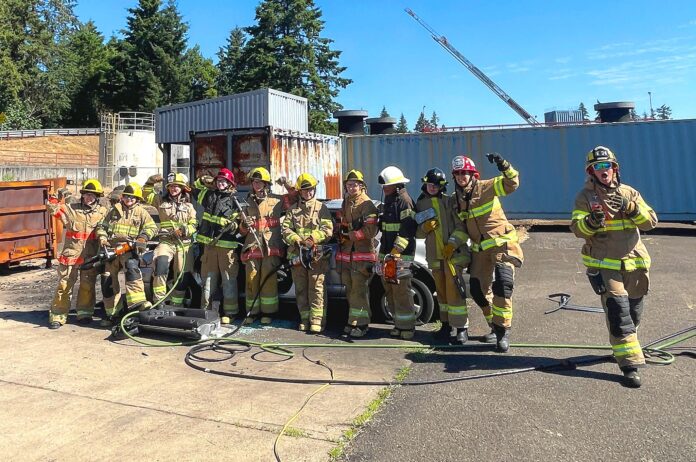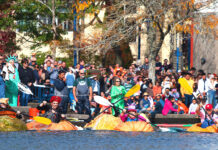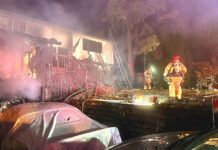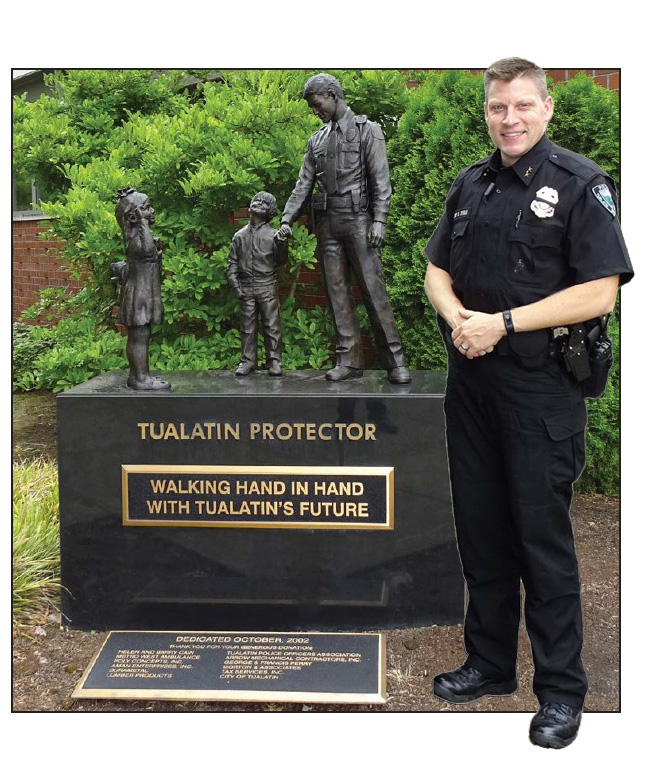It’s not just about climbing ladders and busting down doors; the girls at Metro Fire Camp are wiggling their way toward the slow-growing cracks in the glass ceiling of firefighting.
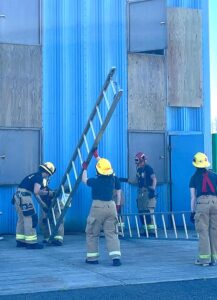
Campers learn to handle a ladder, one of about 15 simulation stations they rotated through at TVF&Rs Sherwood training facility. Holly Goodman/Tigard Life
The camp drew young women ages 16-22 from around the area to Tualatin Valley Fire and Rescue’s (TVF&R) Sherwood training center last month to learn the ins and outs of firefighting and, more importantly, to see there is a place for them in the field.
Everything about the experience is empowering, says Taylor Holliday, a first-time camper considering a career in firefighting.
“I love all the teamwork here,” she said. “From all of the people to all of the things we’ve done, (camp has) taught me there’s more to firefighting than I thought.”
Holliday and her 48 fellow campers spent three days rotating through a series of simulation stations where they learned skills like handling ladders and hoses, prying open a crumpled car using “the jaws of life,” following a hose line through a dark obstacle-laden building and opening blocked doors – which she says is nothing like how it’s portrayed on TV.
Some campers, like Holliday, are interested in the career, others are just curious.
Tuition is free, and their campground is the same facility TVF&R uses for professional training. Their mentors are a crew of female firefighters and paramedics who come from departments around the region to staff and run the camp.
“It’s really about empowerment and building that confidence and leadership, but also, there are young women who may be considering a career in the fire service. This is a great way of getting their feet wet,” said TVF&R’s Corrine Haning.
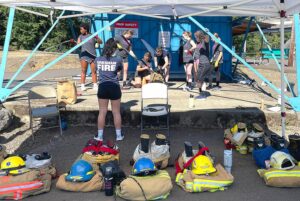
Though Haning isn’t sure how many go on to pursue firefighting, she said TVF&R recently had its first camp alums apply to the department, and about a half-dozen of the professional mentors staffing camp are graduates of the program.
“This is the best time ever. It’s my favorite time of year, fire camp is,” said Portland firefighter Terre Vandewiele.
This year, the camp, one of two operated by a TVF&R and Portland Fire & Rescue partnership, had more than 100 applicants for 50 spots – a good sign for a profession where women still make up less than 5 percent of all employees.
Like many of her colleagues here, TVF&R firefighter Jocelyn Lamoreau had never seen a woman doing her job as a kid, so she never considered it as a possible career.
“I didn’t know any female firefighters. I had no idea that was even an option for me,” she said.
Growing up on Cooper Mountain, in her young mind, they didn’t exist. That changed as a teen during a ride along with her firefighter uncle.
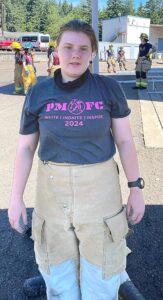
“I met a female firefighter for the first time when I was 19,” she said. “Seeing her do it was a confirmation that (becoming a firefighter) wasn’t unrealistic, and I could find a way to make this work.”
At TVF&R, she’s not alone. The department is about 8 percent women, and while that number is still small, it’s about twice the national average, which has inched from 3 to 4 percent in recent years.
Vendewiele credits the rise of camps like this one around the country with the slight but significant uptick in women entering the field.
“The way you get women to join the fire service and be successful is you give them a community of other women,” she said, “I don’t think anything else in the fire service has been shown to (increase the number of women).”
When Metro Fire Camp launched in 2009, it was one of the first in the country. Though TVF&R didn’t begin hosting a second camp until several years later, it was involved from the start.
The two departments partner on everything from outfitting campers in “turnouts”—the firefighters’ heavy pants and jackets, helmets, boots, and safety gear—to the camp administration. Their structure is the model for dozens of similar camps around the country.
Each girl is issued a complete set, about $3000 in gear, to use for the weekend, and in this male-dominated world, loaners or hand-me-downs sized small enough to fit young women are hard to come by.
Gear sized and cut specifically for women is so recent a development that most of the professionals at camp began their careers making do in ill-fitting men’s gear.
“My first pair of turnouts, I had to unbuckle the first buckle on my jacket. I couldn’t have it fully buttoned because if I did, I couldn’t squat,” she said. “It would restrict my ability to squat because I have hips, and it was a straight cut.”
The non-profit Portland Metro Fire Camp is fundraising to outfit future campers in women’s gear.
“(Camp is) awesome, but with the ability to put them in gear that fits, their experience isn’t hindered by the apparel that they’re wearing,” Vandewiele said.
But the not-quite-right cut of hand-me-down men’s turnouts didn’t appear to spoil the weekend for the enthusiastic group of campers and their mentors, an experience Holliday described as simply “amazing.”


